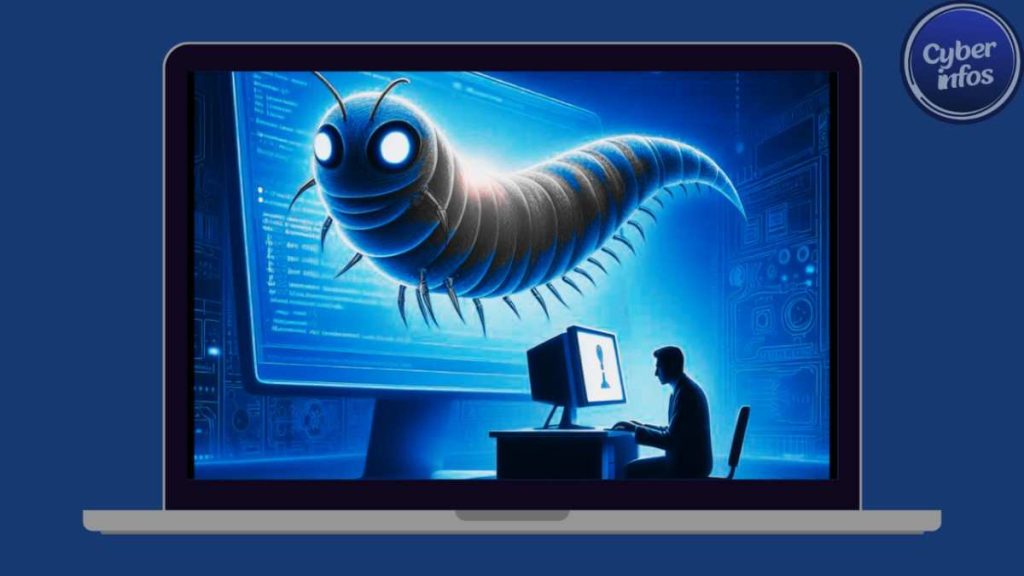Cybersecurity deals with one of the most dangerous digital threats: Computer worms. Unlike a virus, a worm will replicate and spread and cause widespread disruptions, without the user having any contact with the worm itself.
This article will help you understand the computer worms their mechanisms, risk and prevention strategies. For an individual user or an organization, you have to learn to fight these threats.
What Are Computer Worms?
Computer worm also termed as malicious software designed with a purpose of spreading itself around to another network. It does this without attached files or the direct action of the user.
System vulnerabilities allow worms to infect devices and do great and unexpected damage. Unlike traditional viruses, which rely on a host program to kick in, worms are self activating once they break into a system.
Let’s imagine a hacker can remotely control a worm that steals confidential data or overloads network servers. There is also this silent invasion, which can be very destructive if left unchecked as they steal resources, undetected for long periods.
The first computer worm, known as the Morris Worm, was created in 1988 and infected over 10% of the internet’s computers at the time.
How Do Computer Worms Spread?
Computer worms infect in many ways, exploiting the modern connectivity. Common methods include:
Software Vulnerabilities Exploiting
Just like worms, the burglar searches for weakness in the software, operating system or security configurations. And outdated systems are often prime targets because they don’t have the critical patches to block threats.
Phishing Emails
Malicious email attachments spread a lot of worms. Downloading files and clicking on harmful links unknowingly activate threats on unsuspecting users.
Peer-to-Peer File Sharing
File sharing programs propagate some worms. They embed themselves in files that are commonly downloaded, a large pool of devices.
Removable Storage Devices
Worms can infect offline, spreading infection from one system to another on flash drives and external storage devices.
Through these routes worms can infect tens or even hundreds of thousands of computers in a very short amount of time.
The United States is the country most targeted by worms, followed by China and Russia.
What Damage Can Computer Worms Cause?
These computer worms can damage several sectors with great extent. Below are common types of harm they inflict:
Data Corruption
A worm might delete, again, and again, alter, encrypt files, and thus render important information inaccessible. This can mean that companies lose sensitive customer records, financial data or intellectual property for businesses.
Network Overloads
Once you get worms they start to multiply rapidly and fill storage or flood servers with excess traffic. Typically, this results in downtime, which disrupts the operations, and diminishes revenue streams.
Unauthorized Access
Worms can create backdoors which allow hackers to acquire personal data or remote control a system. It can also be used to fuel identity theft or corporate espionage.
Financial Losses
The cost of worm induced damages can be expensive: repairs, system overhauls, and possibly ransom payments. That can also generate financial burdens with regulatory penalties.

Symptoms of a Worm Infection
Early detection of a worm infection is important in minimizing damage. Here are signs that your system might be compromised:
- Internet connectivity slower, or system unresponsive.
- A surge in bandwidth without new activities.
- Unexpected system behaviour or Unauthorized changes to files.
- Outbox that shows emails or messages you did not send.
- A worm could install malware or software without our knowledge.
If you see these signs, you need to act now to prevent further damage.
The most notorious worm attack in recent years was WannaCry, which infected over 200,000 computers in 150 countries within 24 hours.
Strategies to Prevent Worm Attacks
In these strategies are most common to all types of cyber attack prevention methods and Malware prevention to know strategy to prevent attack
Notable Computer Worms in History
The scale of destruction that these infamous worm attacks represent is evidenced by several. Here are a few key examples:
◊ In 1988 one of the earliest worms ( Morris worm ) caused approximately 10 percent of internet connected systems to shut down.
◊ In 2000 ILOVEYOU Worm generated billions in damages by spreading through email attachments that appeared as love letters.
◊ The 2017 WannaCry Ransomware Worm exploited vulnerabilities in Microsoft systems, and affected more than 200,000 computers around the world, including healthcare services.
The healthcare sector is the most targeted industry for worm attacks
Advanced Defense Strategies
Intrusion Detection Systems
IDS tools are used to monitor traffic for abnormalities. These systems can identify when potential worm activity is happening early on before mass infection.
Encryption
Encrypts sensitive data to reduce risks of theft even if attackers can get at it. Online financial transactions are particularly dependent on data encryption.
Incident Response Plans(IRP)
Write down a very detailed protocol for what to do if you are hit by a cyber incident. How you prepare in the event of a breach can significantly decrease the recovery time and return your business to normalcy.
Conclusion
Today’s computer worms are persistent, stealthy threats to this interconnected world. Autonomously spread, they are difficult to combat as a result. But users can protect their systems effectively, by staying informed and proactive.
Defense is built on foundations of preventive habits such as keeping your software up to date, using trusted antivirus tools and trained employees.
Further protection is provided by advanced encryption and firewall implementation. You should know that it is easier and cheaper to address the vulnerabilities early, than after an attack has happened.
However, no matter how hard you work at strengthening cybersecurity, the reward is peace of mind that your data and systems are as well protected as possible from these silent invaders.

